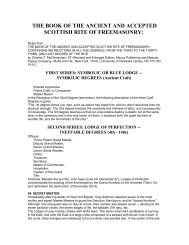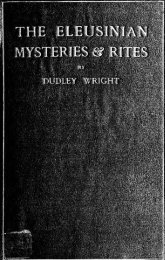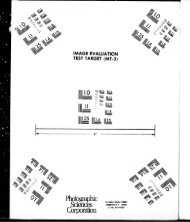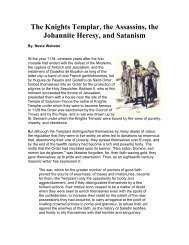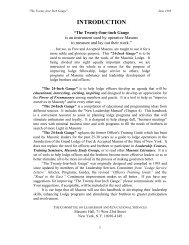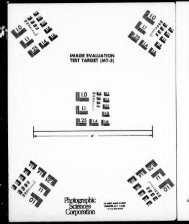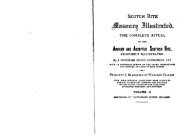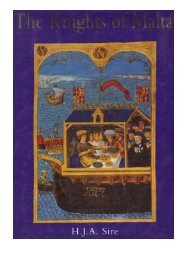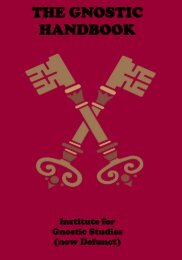The History of Initiation - The Masonic Trowel
The History of Initiation - The Masonic Trowel
The History of Initiation - The Masonic Trowel
Create successful ePaper yourself
Turn your PDF publications into a flip-book with our unique Google optimized e-Paper software.
THE CELTIC MYSTERIES.* 125<br />
egg ; though the instances <strong>of</strong> this form are <strong>of</strong> rare occurrence,<br />
the adytum being more frequently oviform than<br />
43 the Temple; or<br />
serpentine, because a serpent was the<br />
one hundred feet further in the entrance into the outer court was<br />
another stone <strong>of</strong> about twenty feet in height. Within the ditch was a<br />
green walk <strong>of</strong> one hundred and five feet in breadth, which encompassed<br />
the whole structure ;<br />
and this was probably circumambulated by the<br />
aspiraut during the process <strong>of</strong> initiation. <strong>The</strong> building itself consisted<br />
<strong>of</strong> two concentric circles, formed <strong>of</strong> upright and cross stones <strong>of</strong> gigantic<br />
size, the largest being twenty-five feet in height, and <strong>of</strong> a proportionate<br />
breadth and thickness. "<strong>The</strong> bulk <strong>of</strong> the constituent part is so<br />
very great," says Stukeley, (Stonehenge, c. 1.) " that the mortaises and<br />
tenons must have been prepared to an extreme nicety ; and like the<br />
fabric <strong>of</strong> Solomon's Temple, every stone tallied, and neither axes nor<br />
hammers were heard upon the whole structure." <strong>The</strong> outer circle was<br />
one hundred feet in diameter, and consisted <strong>of</strong> sixty stones, alluding<br />
to the sexagenary cycle <strong>of</strong> the Asiatics: one half being uprights and<br />
the other imposts; the inner circle between eighty and ninety feet in<br />
diameter, containing forty stones, in allusion probably to the forty days<br />
prevalence <strong>of</strong> the diluvian waters. <strong>The</strong> adytum was oval, because an<br />
egg was the constant symbol <strong>of</strong> the world ; the outer oval consisted <strong>of</strong><br />
ten stones, because ten was a perfect number, and amongst the Pythagoreans<br />
denoted Heaven, as being the perfection <strong>of</strong> all things, and the<br />
inner oval contained nineteen stones, referring to the cycle <strong>of</strong> the Sun<br />
and Moon, the two great arkite deities. <strong>The</strong> adytum contained an<br />
altar.<br />
43 <strong>The</strong> remains <strong>of</strong> a small temple <strong>of</strong> this kind, consisting <strong>of</strong> sixty<br />
stones, is still in existence at Addingham, in Cumberland, called Long<br />
Meg and her daughters. <strong>The</strong> transverse diameter from east to west<br />
is one hundred yards and the ;<br />
conjugate from north to south, eighty.<br />
On tho south side, at about the distance <strong>of</strong> twenty-three yards, stands<br />
the stone called Long Meg, five yards high, and five yards in girt,<br />
which was the idol or object <strong>of</strong> worship.<br />
43 <strong>The</strong> temple <strong>of</strong> Abury, one <strong>of</strong> the most stupendous erections which<br />
ancient Britain could boast, and whose loss is a national calamity, was<br />
constructed in the form <strong>of</strong> a circle, to which a vast Serpent was attached.<br />
It is considered to have been one <strong>of</strong> the earliest structures<br />
erected in Britain, but now, alas ! totally desolated, and scarcely any<br />
vestiges <strong>of</strong> its existence remain. Its name may probably have been<br />
derived from the Cabiri, as Parkhurst. in loc. ingeniously supposes j<br />
because the Cabiric rites were undoubtedly celebrated within its precincts.<br />
Cabiri, or Abiri, signifies the Mighty Ones j and the mysteries<br />
were dedicated to those benevolent deities who invented and propagated<br />
the arts which elevated man from a savage to a civilized state <strong>of</strong><br />
being. This<br />
extraordinary monument <strong>of</strong> British ingenuity and perseverance,<br />
was erected on the summit <strong>of</strong> an eminence, in the centre <strong>of</strong><br />
an extensive plain, and consisted <strong>of</strong> a great circle, enclosed with a<br />
stupendous vallum <strong>of</strong> earth, within which was a deep ditch. <strong>The</strong> area<br />
<strong>of</strong> this part <strong>of</strong> the temple was twenty -eight acres. On the interior<br />
bank was placed a circle <strong>of</strong> massive unhewn grey stones, generally<br />
about twenty feet in<br />
height. Within this principal circle were two<br />
Smaller double concentric circles <strong>of</strong> stones, each seven feet high. In



